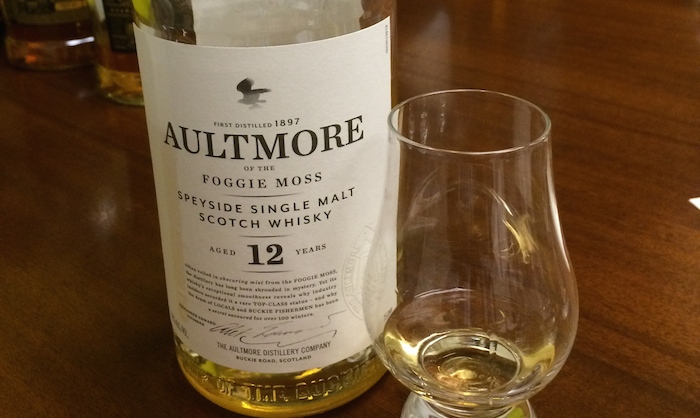Blind-taste someone with scotch and they’ll struggle to tell the difference between blends and single malts. But remove the blindfold and they’ll likely reach for the latter.
Why is that? John Dewar & Sons Brand Ambassador Gabe Cardarella believes the stigma against blends traces back to the ‘80s, when scotch first gained traction in America. Back then, single malts were hot. Some drinkers, Baby Boomers especially, still believe that single malts are naturally superior in quality than blends.
Which makes no sense. Blends contain a number of the single malts that are so desirable on their own. Plus, as Cardarella pointed out, blends account for 90% of scotch sold worldwide.
Thankfully, this stigma seems on the decline. Especially since Millennials will drink whatever is new and tastes good. And they seem on the cusp of understanding scotch. All this bodes well for John Dewar & Sons blended line, the fifth largest blended scotch brand on the planet.
 Though the company has not lost sight of the single-malt lovers, nor the appeal of single malts within the craft-spirits boom. John Dewar & Sons has recently highlighted five of its single malts from their The Last Great Malts brands, including four expressions that are new to the market. These spirits have all been produced for years, but primarily for use in blends.
Though the company has not lost sight of the single-malt lovers, nor the appeal of single malts within the craft-spirits boom. John Dewar & Sons has recently highlighted five of its single malts from their The Last Great Malts brands, including four expressions that are new to the market. These spirits have all been produced for years, but primarily for use in blends.
I had opportunity yesterday to taste this whole line with Cardarella in New York. Brands we sampled were Aberfeldy and Royal Brackla of Highlands, and Autmore, Deveron and Craigellachie of Speyside.
1) Aberfeldy
This brand is unique to the group, as it has been out since the late ‘80s. With its distinct heather-honey flavor, Aberfeldy provides the heart of John Dewar & Sons blends. No surprise then that this standalone product is a showcase of that honey note.
Like all the single-malts in the John Dewar & Sons line, Aberfeldy uses 100% unpeated Scottish barley.
The brand gets its gold label from its distillery’s water source: the Pittiely Burn (“burn” being a Scottish term for river or stream). This Pittiely occasionally surrenders gold to those who sift through its waters. Aberfeldy Distillery will even encourage visitors to do so.
Aberfeldy also bottles Pittiely water for sampling alongside its single malts.
Aberfeldy in the U.S. retails for $45 for the 12-Year-Old and $195 for the 21-Year Old
2) Royal Brackla
John Dewar & Sons recently revived this long dormant brand with 12-year-old, 16-year-old and 21-year-old expressions ($65, $130, $225). The “Royal” in the name refers to events around 1835, when King William IV tried this whisky and liked it so much that he had the distillery ship him scotch.
I could see what captured the King of England’s attention. Of the five whiskies we sampled this was the most unique. What stood out was a waxy, almost-salty note that lingered upon the palate long after sipping. Beyond that it’s a rich, sherried whisky full of fruit and vegetal notes. You’ll want to sit down with this one for exploration.
 3) Craigellachie
3) Craigellachie
Before we sipped this spirit, Cardarella challenged me to pronounce it. Apparently I provided one of the more common mispronunciations: “Craig-a-lackee.” The correct way to say it is “craig-el-ach-ee.”
This scotch is as powerful as tough to pronounce. “Like gun powder through a pineapple,” as Cardarella aptly put it.
Made in the heart of Speyside, Craigellachie’s production includes old-fashioned worm tub condensers. Unlike a shell-and-tube this snakes back and forth, which creates more condensing and helps lend a heavier character to the final spirit.
Craigellachie is available in 13-Year-Old and 23-Year-Old age statements.
4) Aultmore
Around Aultmore distillery, locals have ordered this hard-to-find spirit by asking for “A nip of the Buckie Road.” This owes to its popularity within the nearby town of Buckie.
Aultmore will be easier to find in America now after that John Dewar & Sons has recently released 12- and 18-Year-Old expressions. The whisky has sweet flavors of honey, vanilla, and citrus, with notes of hay and a little salt. There is a spicy bite at the end.
5) Deveron

Released last October, Deveron is light and fruity, with hints of nuts and green apples. For those who like light scotches, this is one to check out.
The lightness owes in part to the shell-and-tube condensers that are lied out horizontally in production. This is where liquids boiled into vapors are condensed into more-purified liquids. Shell-and-tube condensers normally stand up, end over end. A horizontal build reduces the affects of gravity, meaning fewer heavy esters pulled down and a lighter final product.
The whisky comes in green-tinted bottles meant to evoke the image of sea glass. The distillery sits near the mouth of the River Deveron at the North Sea. There is even a Plimsoll line on the bottles. Taken from the hull of ships, this reference mark shows the maximum depth that a vessel can be safely immersed after loading cargo.
Deveron Retails for $45 and $110 for the 12-Year-Old and 18-Year-Old, respectively. A 16-Year-Old is not available in the U.S.
Kyle Swartz is the associate editor of Beverage Dynamics Magazine. Reach him at kswartz@epgmediallc.com and follow him on Twitter at @kswartzz.




